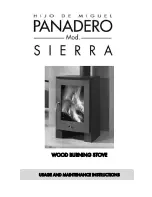
This appliance becomes extremely hot and can produce poisonous gases. A fire guard should be used if children or the infirm are present. The installer is
required to exactly follow these instructions and to completely comply with all relevant local, national and international standards.
Installing a stove is a ‘controlled service’, the law expects that it is either supervised by a qualified installer or that the building inspector is informed. Check with
your local authority.
Asbestos: Your stove does not contain asbestos, but take care to avoid asbestos in an old installation.
Weight: Your stove is heavy – take great care when moving it and ensure that the intended fireplace can support the weight – consider fitting a load distributing
plate.
Your Chimney
Once warm, your chimney makes the gas inside it rise, pulling fresh air into the stove to make it work. Your chimney must:
•
Generate a draught in use of at least 12 Pa (0.05ins wg) and not in excess of 25 Pa.
•
Be capable of withstanding the temperatures generated.
•
Be absolutely incapable of leaking fumes into the dwelling – this will commonly be achieved by it:
•
Being at least 5m high.
•
Terminating at least 1m above any roof ridge.
•
Having an internal cross-‐section not less than 0.018m² (e.g.: 150mm dia) and never more than 0.14m² (e.g.: 375 x 375mm).
•
Being free from even the slightest crack or source of leakage.
•
Having no bends sharper than 45°.
•
Being entirely free of obstructions and swept by a qualified chimney sweep.
•
Being connected to only this stove.
•
Being of thick masonry or otherwise adequately insulated.
•
Conforming to local building regulations.
Special rules apply where the flue passes through timber, thatch or other vulnerable materials – take specialist advice.
Although it is possible to access the chimney through the fire with the throat plate removed, fit hatches for cleaning access if needed.
Your Fireplace
Stoves become very hot, the setting must be made entirely of durable fireproof materials. Thin (<50mm) stone slabs risk cracking unless cut into sections to
allow for expansion and backed with a heat resistant concrete. Even beyond the safety clearance , items can become very hot -‐ take great care in siting
vulnerable materials like wax, textiles, paper etc.
Air Supply
Your stove needs air to breathe – there must be a permanent fresh air supply into the space in which it is installed equal to the size given on page 1. This can
often be provided by air leaking around door frames etc. (it is commonly accepted that this alone may suffice for appliances <c5kW) but in case of any doubt, fit
a purpose made air vent. An extractor fan, or another fuel using appliance in the same building, can remove this air.
Fit a Carbon Monoxide alarm near to the stove.
Regarding installations in rooms with extractor fans:
For solid fuel appliances: avoid installing extract ventilation in the same room. If mechanical extraction is unavoidable then seek specialist advice to ensure the
installation is tested for the safe operation of the appliance.
A suitable test would be to check for spillage when appliances are subjected to the greatest possible depressurisation. A prerequisite for this condition is that all
external doors, windows and other adjustable ventilators to outside are closed. The depressurisation at the appliance will depend on the particular combination
of fans in operation (fans in the room containing the appliance and fans elsewhere in the building) and the pattern of open internal doors, hatches etc. which is
established at the time of the test (when fans should be on their maximum useable setting), and the specific combination causing the greatest depressurisation
at the appliance depends upon the circumstances in each case. Several tests (which should include a test with the door leading into the room of installation
closed and all fans in that room switched on) may therefore be necessary to demonstrate the safe operation of the appliance with reasonable certainty. The
effect of ceiling fans should be checked during the tests. Extra ventilation should be supplied if tests show that this is necessary.


























